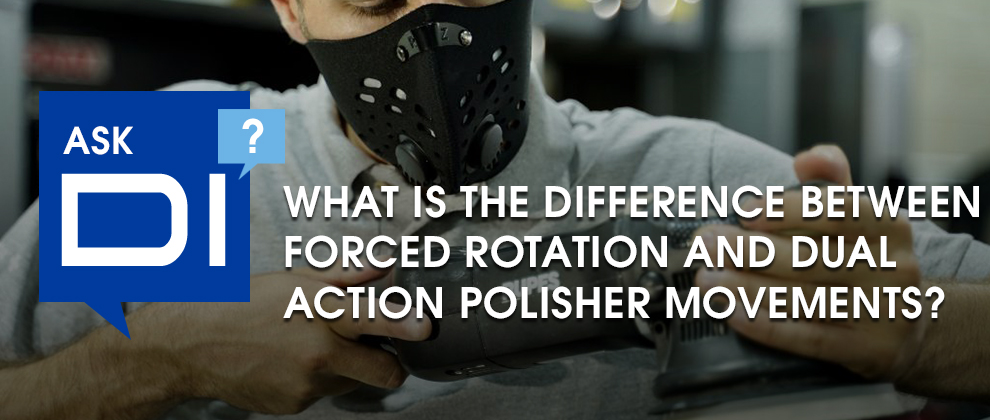Ask DI: What is the Difference Between Forced Rotation and Dual Action Polisher Movements?
by Reece @ DI
In this series, I am going to take some time to highlight some of the most popular detailing questions I encounter on a daily basis as a customer service representative here at DI. These questions can range from washing, drying, polishing, to almost any other step in the detailing process. Check out our answers and some helpful detailing resources covering the topic at hand.
Question:
As a novice to detailing I appreciate all of your polisher articles and basic product overview pages. I spent a good chunk on lighting last month when you had the Scangrip sale, but decided to “buy it once, buy it right.” Next goal it to do the same on a couple of polishers when (hopefully) those are on sale.
After reading the polisher guide page I remain unsure what to choose on a few points.
- As opposed to most random orbital machines, you also show a few as “forced random orbital” and others as “forced rotation.” Is this just an accidental difference typed in for the same technology, or is there an actual difference?
- “Forced rotation” would benefit from explanation. Without prior expertise, all of these motorized tools seem like “forced” rotating tools in a way, but probably there is an unstated nuance here.
- “Random Orbital” vs “Dual Action”… these seem to potentially be synonymous in some places, but in others possibly distinct with no explanation.
I’m willing to invest more if needed for the right equipment, but just need to be confident I understand what I am getting and why. The guide was definitely helpful but filling in the above gaps would be a plus for beginners. What exactly is the difference between forced rotation and dual action polisher movements?
Answer:
With polishers, we have dual action units (also known as random orbital) and rotary units. DA units will not only spin in a circle, but the backing plate will bounce away from the center of the unit, providing you with two different movements. Rotary units will only spin in a circle and when you add the second movement that DA units have, it cuts down on heat generation and greatly reduces the possibility of damaging the paint during polishing.
Forced rotation or forced random orbital units are exactly the same, just different terminology. These units are dual action units but they are forced to spin. When using some dual action units, you will find that at times they can bog down or stall. This is due to using too much pressure or if the user is holding the unit in a way in which the backing plate and pad are not level to the paint surface. While rotary units spin and just keep spinning, the safety of dual action units does bring in some of that bogging down that I mentioned. When you add in the forced rotation to the two movements of the backing plate, it adds in that element of a rotary in which the backing plate keeps, or is forced to, keep spinning. This stops bogging down and aids in correction for heavy imperfections or when you need to add more pressure to the unit.
With that said, new technology of “long throw” units has come into play. For example, Rupes units. These long throw polishers are dual action units, however, while traditional dual action units would have the backing plate move 6-8mm from the center of the polisher to achieve the dual action motion, long throw units bring that distance up to 12mm, 15mm, or even 21mm depending on the unit. The larger the throw, the quicker you can remove imperfections from the surface.
I love long throw units and tend to reach for these the most out of anything on the market. For me they provide a great deal of correction power, while avoiding the risks that come with a rotary unit. I personally do not come across imperfections deep enough that would warrant a forced rotation unit, but these are fantastic polisher options as well.
Forced Rotation or Forced Random Orbital
Random Orbital or Dual Action
- Rupes BigFoot Random Orbital Polisher
- Rupes iBrid Mini HLR75 Polisher
- Griot’s Garage G8
- Griot’s Garage G9
- Griot’s Garage Long Throw Orbital Polisher G15 and G21
- Flex XCE 10-8 125
- Griot’s Garage G13 Mini
- Griot’s Garage GR3 Mini
- Griot’s Garage THE BOSS Hybrid Micro Polisher
- Porter Cable 7424 XP Random Orbital Buffer
- Flex XFE 15 150 18.0 Cordless Polisher Set
- Flex XFE 7-12 80 Random Orbital Polisher 3″
- Flex XCE 8 125 18.0 Cordless Polisher Set
- Meguiar’s MT300 Dual Action Polisher
Dual Action & Rotary
Bonus Articles
- Tutorial: How to Prep a Car for Polishing
- 1 Step, 2 Step, The various Types of Polishing Process
- Assessing Paint Condition and Deciding on a Correction Process
- Polishing Pads: How Many Should I Use?
- The 5 Key Elements to Proper and Effective Paint Polishing








No comments yet. Be the first!